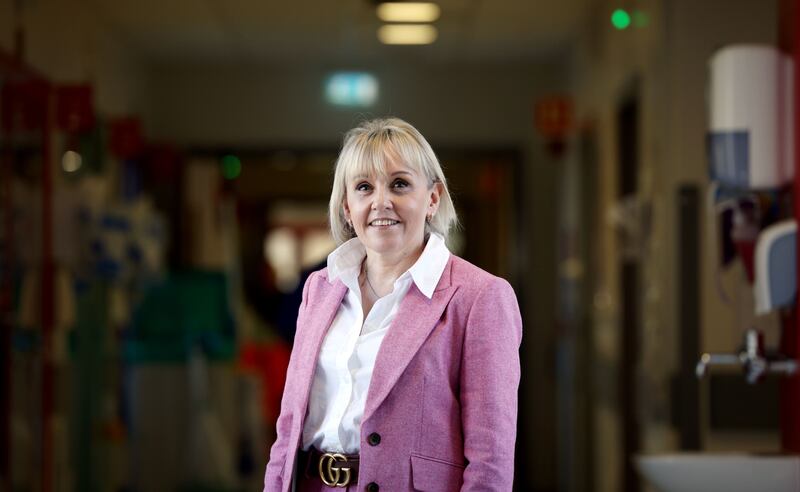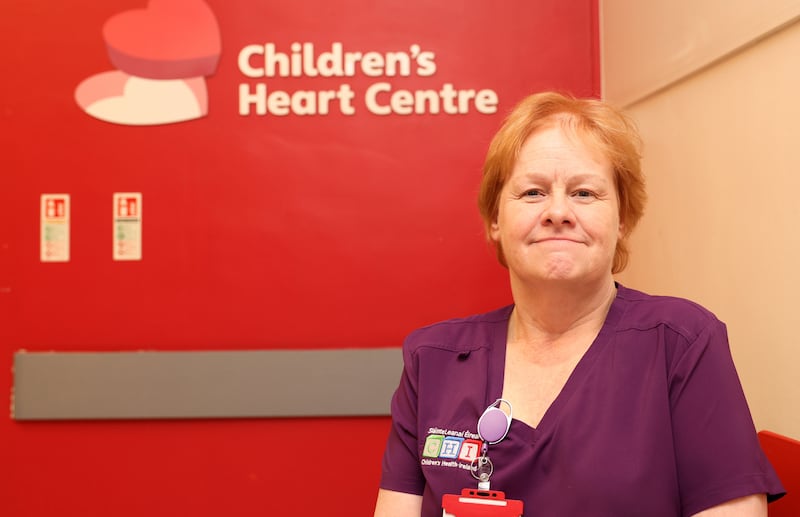Deep in the maze of Crumlin’s children’s hospital in Dublin, a quiet revolution in the care of the sickest and most fragile patients is under way.
Thanks to early screening and new clinical techniques, the prospects for children born with congenital heart disease have never been better.
The vast majority attending the Children’s Heart Centre will leave with a repaired heart following a single intervention and go on to lead full and productive lives.
The centre, which this month marks its 10th anniversary, is also one of the most successful examples of cross-Border collaboration. Since 2015, children from Northern Ireland with cardiac conditions have been sent for surgery to Crumlin, with aftercare provided back home.
Every year, about 500 children in Ireland are born with serious heart disease, and are likely to need surgery or a cardiac catheter in the first year of their life
— Prof Orla Franklin, cardiologist
“The heart is the most complex organ in the body,” cardiologist Prof Orla Franklin says on a tour of the busy unit, “and the organ most likely to go wrong”.
“Every year, about 500 children in Ireland are born with serious heart disease, and are likely to need surgery or a cardiac catheter in the first year of their life.”
The centre performs 450 cardiac surgeries a year and 700 cardiac catheters. “What we do has changed over the last number of years,” Franklin explains. “Before, everyone had surgery; everyone got a scar. But we’ve become very good at trying to managing heart disease interventionally.”

Adult heart disease is traditionally treated by means of an angiogram and, if needed, the insertion of a stent, without the need for a coronary bypass. These techniques are now available, downsized, for children.
The insertion of a catheter in the groin, performed under anaesthetic, allows for the fitting of a stent. What used to required two weeks in hospital and lead to long-term complications is now done, usually successfully, as a day case.
“In order to be good at this, you need a concentration of expertise, people who are doing nothing but this all the time,” Franklin says. Out of this imperative grew a unique cross-Border initiative, the All-Ireland Cardiac Children’s Network in Crumlin.
“It became clear Northern Ireland was struggling to maintain expertise because they didn’t have the population to support it, and to allow specialists perform the necessary volume of work to keep up their skills.”
The vast majority of our children will have one cardiac surgery. That will fix them. They may need surveillance but not chronic cardiac care
— Prof Orla Franklin
The centre, now jointly funded by the HSE and the Health and Social Care Trusts of Northern Ireland, has been a win-win for patients and staff. Children from the North account for up to 20 per cent of heart interventions performed in Crumlin.
Most children here will benefit from treatment with minimally invasive techniques. “By and large, if you close a hole with a patch, the hole doesn’t grow as the child gets older,” says Franklin.
“The vast majority of our children will have one cardiac surgery. That will fix them. They may need surveillance but not chronic cardiac care.”
Nonetheless, there are the children with more complex conditions.
“Approximately 80 per cent of children will have their cardiac hole or valve fixed and that’s the end of it, but for 20 per cent we are looking at a lifetime of intervention,” Franklin says. “We can make their cardiac issues better but we cannot fix them.”
Two-and-a-half-year-old Maya, sitting calmly on a bed with her parents while eating chocolate, is something of a regular in Crumlin.
Her mother Sinead Fitzgerald remembers the moment when Maya was diagnosed with congenital heart disease. “We brought her in at three months when her breathing was laboured and she wasn’t feeding properly.”
Maya’s father Shane Kelly recalls.“We knew nothing. We just came in to make sure. It was lucky we had come to the heart centre of Ireland.”
“I was driving here thinking they’re going to be saying ‘ah, first-time parents,’” Sinead says. “Looking back, I wish that’s what it was.”
Maya needed surgery at three months, and again two years later, which was completed successfully.
The original sudden diagnosis was shocking, her mother recalls. “You grieve for this life you thought you’d have, even though you’re so grateful she was born. You have all these plans, but you have to learn to adjust them. You know she needs you and you have to support her.”
Our job is to support families to reorient themselves to a new reality. It may be a lifelong reality, or their child might live only a very short time, depending on diagnosis and prognosis
— Catherine Matthews, paediatric cardiac psychologist
Strong family support has helped with the challenges, she says, as has the support provided by other families going through the centre: “I realised that if they can get through it, so can I.”
As a paediatric cardiac psychologist, part of Catherine Matthews’ work is to help families through the sometimes traumatising diagnoses they receive.
“Our job is to support families to reorient themselves to a new reality. It may be a lifelong reality, or their child might live only a very short time, depending on diagnosis and prognosis,” she says.
“In the short term, we try to support families to feel some of the grief, to make space for that when there is a lot of to-do.”
Early screening is behind this transformation of cardiac care for children. Three out of every four patients in the unit received their diagnosis in the womb, at their mother’s 22-week scan.
[ Children’s hospitals ‘extremely busy’ due to increasing number of RSV patientsOpens in new window ]
“It’s much better that way than for the women to end up here for the first time with a critically ill child and they’re going ‘oh my God’,” Franklin says.
In 20 years as a healthcare assistant, Marie Faulkner has seen many changes. Progress in medicine means the children needing attention are the more severe cases than before.

“It’s wonderful to see a baby who has been so sick go home. Then we have older children, whose prognosis was uncertain. They come back as teenagers and you see them making their lives – there’s a nice continuity to that,” Faulkner says.
“There can be loneliness, and fear, and so you try to make a difference. There’s definitely more joy here than heartbreak.”
Once a cardiac condition is diagnosed in utero, the wider team kicks in to support the parents. At this stage, it’s as much about practical help and psychological counselling as medical treatment. Having a baby with a serious heart condition can be a big financial drain. On average, working mothers stay at home for two years.
Franklin says: “No one is going to look after a baby with a nasogastric tube. No one will babysit for you. They might make a dinner and look after your other children but they not going to look after them, so care is largely delivered by parents who have to take time off work.
“It is much easier to fill the forms for domiciliary care allowance when you’re seven months pregnant than when you have a seven-day old baby who needs to be ventilated. We try to line up women for every assistance the State can give to make this undoubtedly disastrous situation a little easier.”
Until the Covid-19 pandemic, some Irish children with complex heart conditions were sent to the UK for treatment; now, only transplant patients cross the water – about one or two a year. Numbers remain too small to justify doing cardiac transplants on children in Ireland.
The unit was built at a cost of €4.5 million entirely with donations; mostly “cake sales and fun runs”, as Franklin puts it. Rugby stars Johnny Sexton and Ronan O’Gara helped to raise some bigger donations and golfer Graeme McDowell chipped in with a substantial cheque.
The number of children attending the unit has remained relatively constant.
Moving to the new national children’s hospital at St James’s won’t result in any more space, though there will be parental accommodation in all rooms. The biggest gain is likely to be greater access to intensive care.
“We can get it all right and line a child up for surgery but it’s absolutely no use if there isn’t a bed available in intensive care. They all need to go there after intervention.”
Franklin’s big worry is that long-term nurses and other staff will opt not to transfer to the new facility: “Sometimes people vote with their feet; this might be a natural time for some to change direction.”




















